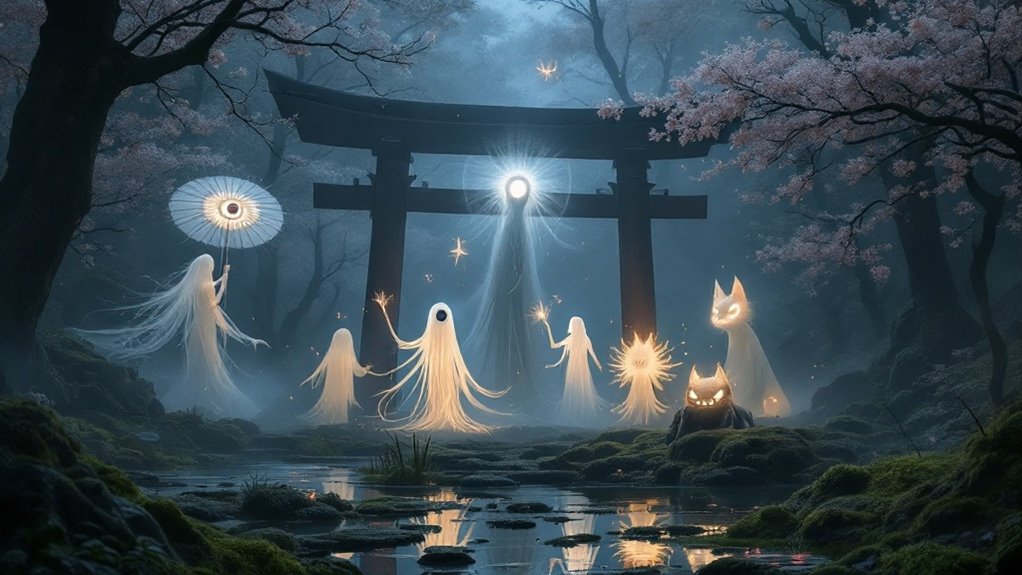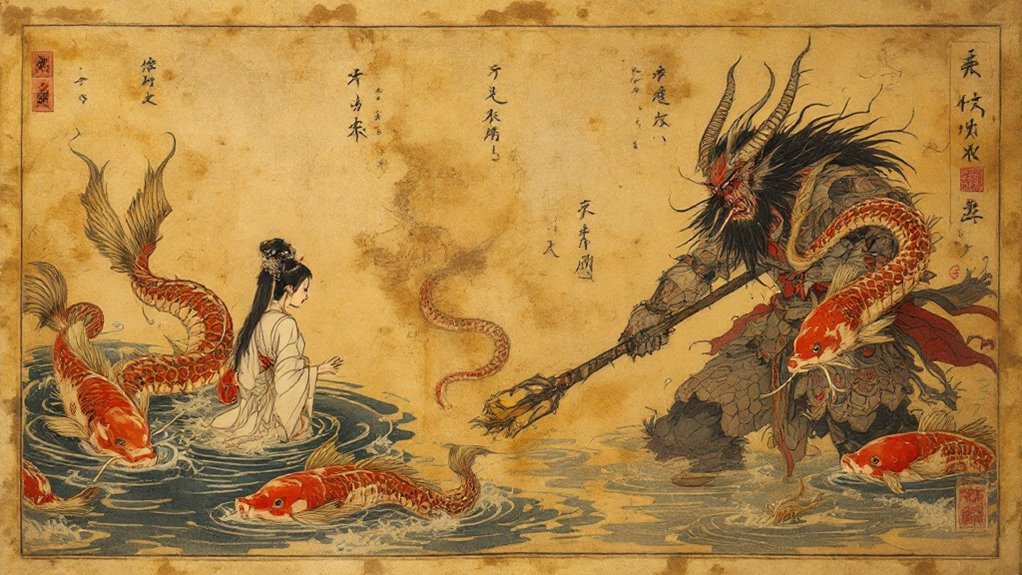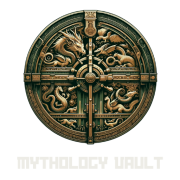Yokai: The Ever-Changing Faces of the Supernatural
Venturing into the fascinating realm of yokai, Japan's enigmatic supernatural beings, it becomes clear that these shape-shifters offer us more than just a glimpse into ancient superstition. On closer inspection, yokai provide a mirror for our own transformative abilities and the human experience.
Whether we look at the quick-witted kitsune or the haunting ubume, each yokai embodies not only cultural fears and hopes but also the complex social dynamics at play in Japanese society.
What sets yokai apart from other mythological creatures is their unique ability to transform from everyday objects into powerful entities. This reflects the core Shinto belief that all things possess a spirit, infusing the world with a sense of wonder and magic. By examining yokai through this lens, we can gain a deeper understanding of the Japanese psyche and how it continues to influence modern society.
So, let's explore how these shape-shifting beings mirror our own transformative nature, embodying the complex tapestry of hopes, fears, and social dynamics that continue to shape Japan's rich cultural heritage.
Yokai: The Transformers
While many might dismiss yokai as being mere relics of Japan's superstitious past, delving deeper into these supernatural beings reveals profound insights into the human mind and our collective need to find meaning in the mysterious. Compared to mythological creatures from other cultures, yokai possess a uniquely Japanese ability to transform from mundane objects into powerful entities—a trait that mirrors the Shinto belief that everything possesses a spirit.
From the mischievous kitsune to the tragic ubume, each yokai archetype embodies cultural fears, hopes, and social dynamics that continue to resonate with us today. Let's explore how these shape-shifting beings reflect our own transformative nature.
Yokai: A Japanese Mirror of Ourselves
When we peer into the realm of yokai, we fleetingly glance at supernatural beings that have captivated Japanese imagination for generations. However, upon closer inspection, it becomes apparent that these enigmatic entities offer more than a mere look at outdated superstitions.
Yokai, with their unique ability to morph from the everyday to the extraordinary, serve as a looking glass into our shared humanity. The fox-like kitsune, with its quick wit and shapeshifting prowess, embodies the duality of human nature. The tragic tale of the ubume, a spirit born from the grief of a mother, reflects the depths of human emotion.
Each yokai, in its own way, mirrors a facet of the human experience—be it our hopes, our fears, or the complex social dynamics that shape our world. By examining yokai through the lens of Shintoism, a belief system that sees spirits in all things, we can gain a deeper understanding of the Japanese psyche.
We see a world where the mundane and the magical coexist, where nature and human experience intertwine to create a rich tapestry of stories and beliefs that continue to resonate in modern Japan. So, let us venture into this realm of shapeshifters and discover how yokai not only reflect our own transformative nature but also serve as a bridge between ancient traditions and the modern world.
Origins in Ancient Japanese Culture
I've delved into the ancient origins of yokai, Japan's supernatural beings, and discovered how these creatures emerged from the nation's 8th-century consciousness. The stories of yokai are deeply intertwined with indigenous beliefs combined with imported Buddhist and Taoist philosophies. Through my research, I've learned that these mythical beings sprang from isolated regional folklore, with each area developing its unique spirits before the Yamato clan united Japan. These tales were primarily shared through oral storytelling traditions that passed from generation to generation.
Regional Yokai Through the Ages
The rich tapestry of yokai narratives unfolds distinctly across Japan's varied landscapes, with each region contributing its own supernatural inhabitants to the nation's mythological pantheon. I've traced these regional variations back to the 8th century, where isolated tribes developed unique folklore to explain their local phenomena and fears. Today, these supernatural entities continue to thrive as strange phenomena persist, demonstrating the enduring nature of yokai in Japanese culture.
What fascinates me most is how these regional stories transformed during the Edo period's golden age. I've found that when the printing press emerged, formerly isolated tales began crossing borders, creating a nationwide exchange of supernatural beliefs. Through Toriyama Sekien's detailed catalogs and the popular Hyakumonogatari Kaidankai storytelling tradition, I've seen how these regional yokai evolved from local mysteries into shared cultural touchstones. Even as modernization threatened their existence during the Meiji period, these regional spirits proved resilient, adapting to new forms of expression.
Transformative Powers of Yokai Beings

The transformative powers of yokai beings are a fascinating aspect of Japanese folklore that mirrors shapeshifter patterns found in mythologies worldwide, yet carry unique cultural significance. Through my studies, I discovered how everyday objects can absorb human emotions and experiences, evolving into supernatural creatures with distinct personalities and abilities. What captivates me most is how yokai command over natural elements reflects humanity's eternal desire to understand and control the forces that shape our world, from gentle morning mist to fierce mountain storms. These supernatural entities showcase enhanced physical capabilities when transformed, as evidenced by their heightened speed, strength, and durability during battles.
Shape-Shifting Through Time
With roots spanning centuries of Japanese folklore, yokai's extraordinary ability to shape-shift emerged as one of their most defining characteristics during the Heian Period (794-1185) and flourished throughout the Edo Period (1603-1867). I'm fascinated by how these supernatural beings mastered transformations across multiple forms, from animals to humans to natural phenomena.
| Form Type | Examples | Cultural Meaning |
|---|---|---|
| Animal | Kitsune (foxes), Tanuki (raccoon dogs) | Wisdom, Trickery |
| Object | Tsukumogami (haunted objects) | Life in All Things |
| Human | Disguised Spirits | Social Commentary |
| Natural | Wind, Water | Elemental Power |
| Hybrid | Mixed Forms | Spiritual Evolution |
In contemporary times, yokai's shape-shifting legacy persists through art, literature, and media, imparting lessons about the fluid nature of existence by depicting transformation as more than just a change of form.
Daily Objects Turn Supernatural
Within the mystical domain of yokai, everyday items like umbrellas, teapots, dolls and swords can take on extraordinary powers after a century of existence or neglect.
I've discovered that these transformations reflect Japan's deep-rooted animistic beliefs, where every object possesses a spiritual essence waiting to awaken. For example:
- The forgotten umbrella in your closet yearns for one last performance in the rain
- Your grandmother's cherished teapot still holds centuries of untold stories
- That discarded doll in the attic now has painted eyes that follow passing shadows
- An abandoned sword remembers battles long past
These object yokai serve as powerful reminders that everything we create and use carries spiritual weight. They teach us that disrespect towards our possessions can trigger supernatural consequences, transforming the ordinary into the extraordinary.
Power Over Natural Elements
Everyday objects becoming yokai through time and neglect demonstrate one aspect of supernatural power, but observation reveals yokai hold an even more potent ability – command over nature itself. The influence yokai exhibit over wind, water, fire, and earth resembles the elemental forces found in Western legends.
Witnessing tengu spirits control mountain breezes and kappa habitation in sacred waters illustrates the deep bond between humanity and the natural world. The mastery yokai display over the elements mirrored in our desire to understand and control our surroundings.
Beings like bakeneko igniting flames with their tails and kami blessing harvests embody the complex dynamics between humans and nature – a mix of respect, reverence, understanding, and liberation.
Natural Phenomena and Yokai Explanations
Understanding natural phenomena through yokai tales reveals humanity's enduring need to explain the mysterious forces that shape our world. I find it fascinating how these supernatural beings serve as bridges between the explainable and inexplicable in Japanese culture.
Kappa stories highlighting the deadly power of water connect human fear to survival instinct. Yamabiko's mountain echoes remind us of nature's mystical voice. Awe of weather's raw force is reflected in tales of Susano-o's storms. Amabie's disease prophecies demonstrate our quest to understand illness.
When I examine these yokai stories, I see a system of belief that helps people cope with nature's unpredictability. The supernatural explanations aren't just superstitions – they're cultural tools that have helped generations understand their environment and maintain respect for natural forces.
Artistic Portrayals Across Time

Brushstrokes and ink have long captured the essence of yokai in Japanese art, transforming these fearsome spirits into beloved cultural icons. From medieval scrolls to modern interpretations, I've observed how these supernatural beings evolved from terrifying entities to endearing characters.
| Period | Key Works | Cultural Impact |
|---|---|---|
| Medieval | Tsukumogami Emaki, Hyakki Yagyō | Established foundational yokai narratives |
| Edo | Toriyama Sekien's works, Ukiyo-e | Standardized yokai appearances |
| Modern | Theater, Ceramics, Prints | Popularized yokai as cultural symbols |
Toriyama Sekien's 1776 masterpiece, "The Illustrated Night Parade of 100 Demons," ignited a cultural revolution. Artists like Tsukioka Yoshitoshi brought new depth to yokai representation through woodblock prints and theatrical performances. These supernatural beings transcended their frightening origins, becoming powerful symbols of Japan's creative spirit.
Yokai's influence can also be seen in modern Japanese art and popular culture. From Mizuki Shigeru's manga "GeGeGe no Kitaro" to the "Yo-kai Watch" video game series, these creatures continue to captivate audiences of all ages. Their enduring appeal lies in their ability to embody both the bizarre and the familiar, making them an integral part of Japan's rich cultural heritage.
Modern Media and Yokai Evolution
Three major shifts define yokai's evolution in modern media, transforming them from fearsome spirits to relatable characters, vessels for social commentary, and adapters to digital storytelling. The once-feared apparitions have become mirrors reflecting contemporary struggles.
Modern anime and manga now comfort us with once-terrifying spirits.
Yokai embody battles with societal pressure and conformity, resonating with our experiences.
These beings critique our relationship with technology and consumerism, showcasing their power.
The evolution from feared entities to beloved icons is evident in their cultural impact.
In today's digital world, yokai serve as archetypes, bridging ancient wisdom with current challenges. They've become companions in storytelling, helping navigate life's complexities while retaining their mystical essence.
Frequently Asked Questions
Can Yokai Be Permanently Destroyed or Killed?
Like threads in an eternal tapestry, yokai are indelible. While I can temporarily defeat or physically purify them using exorcism rituals, the yokai ultimately transform or reincarnate rather than succumb to permanent destruction.
Do Yokai Have Hierarchies or Social Structures Among Themselves?
I've found that while traditional yokai lore doesn't establish rigid hierarchies, yokai often have a social pecking order of sorts. They seem to follow a structure influenced by their types, powers, and territories – not unlike how animals and insects organize themselves in nature.
For example, tengu, being powerful, bird-like yokai, are sometimes portrayed as leaders or guardians. Kappa, known for their mischievous nature and water-dwelling habits, might form their own little groups near ponds and lakes.
There are also instances where yokai team up with each other, while still keeping to themselves. Kitsune and tanuki are sometimes depicted as companions, with the fox's cunning and the tanuki's shapeshifting abilities complementing each other.
This kind of social structure is never explicitly stated in the original folklore, but it's something that can be inferred through the various yokai stories and encounters recorded through history and popular culture. The organization is, after all, something that komt naturally to these supernatural creatures.
How Do Japanese Households Protect Themselves From Malevolent Yokai?
Japanese households protect against malevolent yokai through various spiritual measures. They often display ofuda charms, shimenawa ropes, and images of protective spirits. Families may also make offerings or perform rituals to ward off harmful yokai.
Are There Specific Times or Seasons When Yokai Are More Active?
I've observed that yokai are most active during seasonal shifts, especially spring and fall. Like ancient spirits worldwide, they're most powerful at dusk and dawn, mirroring nature's liminal periods of change.
Can Humans Become Yokai Through Specific Actions or Circumstances?
Humans can transform into yokai through tragic circumstances like violent deaths, unfinished business, or dark rituals that lead to spiritual corruption. It's a path marked by intense emotions and suffering.


